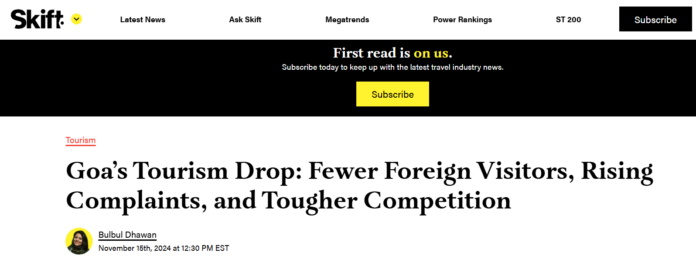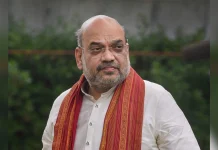Some so-called social media influencers are busy spreading fake news that foreign tourists are avoiding Goa. In fact, they have now fallen silent after the government released data. Who are behind these fake narratives?
Aniket Ahuja
In November last year, Ramanuj Mukherjee, who has a a large following on X, formerly Twitter, made a sensational announcement. As if he was declaring ‘breaking news,’ he claimed that foreign tourists were avoiding Goa and that they are opting for Sri Lanka.
However, his claim lacked any credible data or sources. While some viewers may have been sceptical, a surprising number took his words at face value.
One user responded, speculating, “Perhaps it’s due to poor infrastructure and high costs.”
What made matters worse was that a media outlet picked up this baseless post and turned it into a full-fledged news story.
Then, two months later, the Goan government released official tourism data. From that moment, those who had spread the false narrative fell silent.
“Goa welcomed over 1.04 crore (10.4 million) tourists in 2024,” stated the government report. “This marks a significant rise from 86.28 lakh (8.62 million) visitors in 2023, reflecting a 21% year-on-year increase in overall tourist traffic.”
During a recent discussion with Aseemaa, Tourism Director Suneel Anchipaka elaborated on how the government gathers data. “We source information from Goan airports, Konkan Railways, and Kadamba Transport Corporation Limited (KTCL),” he explained.
The perception of declining tourism often stems from isolated incidents, not from actual official data.
So-called influencers on social media shared videos of empty beaches and deserted markets. However, a closer look at these videos revealed a crucial detail—they were filmed during the afternoon.
Anyone familiar with Goa knows that from 12 to 4 p.m., the scorching sun keeps people indoors. These videos were not fake but strategically shot, much like how WWE events rotate audiences for effect. In the same way, Goa’s streets appear empty due to timing. It was a carefully crafted illusion.
Analysing the demographics of foreign tourists is essential for understanding fluctuations.
Before the pandemic, most international tourists visiting Goa were from Russia and Israel. During the peak season from November to February, Dabolim Airport saw an influx of seasonal chartered flights from Russian cities such as Moscow, St. Petersburg, Yekaterinburg, and Kazan.
Anyone with a basic understanding of global affairs would recognize this trend. Russia has been engaged in war with Ukraine since February 24, 2022. Meanwhile, Israel has been grappling with a conflict with Palestinians since the October 7, 2023 attack. Under such circumstances, a decline in tourists from these countries is entirely expected.
Dispelling the Myths
Some social media accounts attributed the supposed decline in tourism to poor infrastructure. “This claim is completely false,” Anchipaka asserted.
In reality, Goa’s infrastructure is thriving. The Manohar International Airport, inaugurated in December 2022, is a prime example. Built at a cost of ₹3,000 crore in Mopa, North Goa, it handled over 4.4 million passengers in FY 2023-24, nearly reaching its 4.5 million annual capacity.
On average, the airport manages 100 aircraft operations and 15,000 passengers daily, ranking it as India’s fifteenth busiest airport.
Despite the emergence of this new airport, the existing Dabolim Airport continues to play a vital role. Dabolim served around 8.5 million passengers in FY 2022-23. Even after the launch of Manohar International Airport, Dabolim remains a crucial gateway to Goa, showcasing the state’s growing ability to accommodate a rising influx of visitors.
Diversifying Tourism Offerings
Goa’s tourism appeal is no longer limited to its sun-kissed beaches. It is actively promoting our rich cultural heritage, ecotourism, and adventure sports to attract a more diverse range of visitors.
For instance, the Chikhal Kalo festival, a traditional mud festival celebrating Lord Krishna’s childhood, and São João, an annual Catholic festival filled with colorful traditions, offer unique experiences for both domestic and international tourists.
The Nagpur-Goa Expressway will greatly enhance connectivity, making travel to Goa easier and fostering regional growth. This highway is expected to significantly reduce travel time, making Goa more accessible to tourists from Central India.
The state is also shifting its focus to attracting high-value visitors. “We are witnessing a rise in high-end tourism, as reflected in increased hotel occupancy rates and the number of registered accommodations, which has surged from over 3,000 in 2022 to nearly 9,000 in 2024. This expansion provides tourists with a greater variety of lodging options, including homestays, enriching their experience,” stated the official.
Cracking Down on Fake News
Anchipaka acknowledged that certain individuals have been attempting to tarnish Goa’s reputation. “We are taking stringent action against these offenders,” he affirmed. ”
All social media accounts responsible for spreading this misinformation are facing legal charges under IPC 505, which addresses public mischief, and Section 66D of the IT Act 2000, which deals with cheating through impersonation using computer resources.
Tourism Minister Rohan Khaunte also weighed in on the controversy. “These so-called social influencers were paid to spread falsehoods… they appear to have become anti-Indians,” he told Aseema.
“They come here solely for financial gains and then try to defame Goa,” he added. “Luxury hotels reported near-full occupancy during peak seasons, clearly indicating a thriving tourism industry.”
While acknowledging minor concerns, Khaunte dismissed the idea that they overshadow Goa’s overall appeal. “Yes, there are connectivity and transportation issues that need attention, but they do not define Goa,” he said.
When asked about comparisons between Goa and Thailand, he responded firmly, “Goa’s beauty is unmatched… we don’t want to turn Goa into Thailand. We want Goa to remain Goa.”








